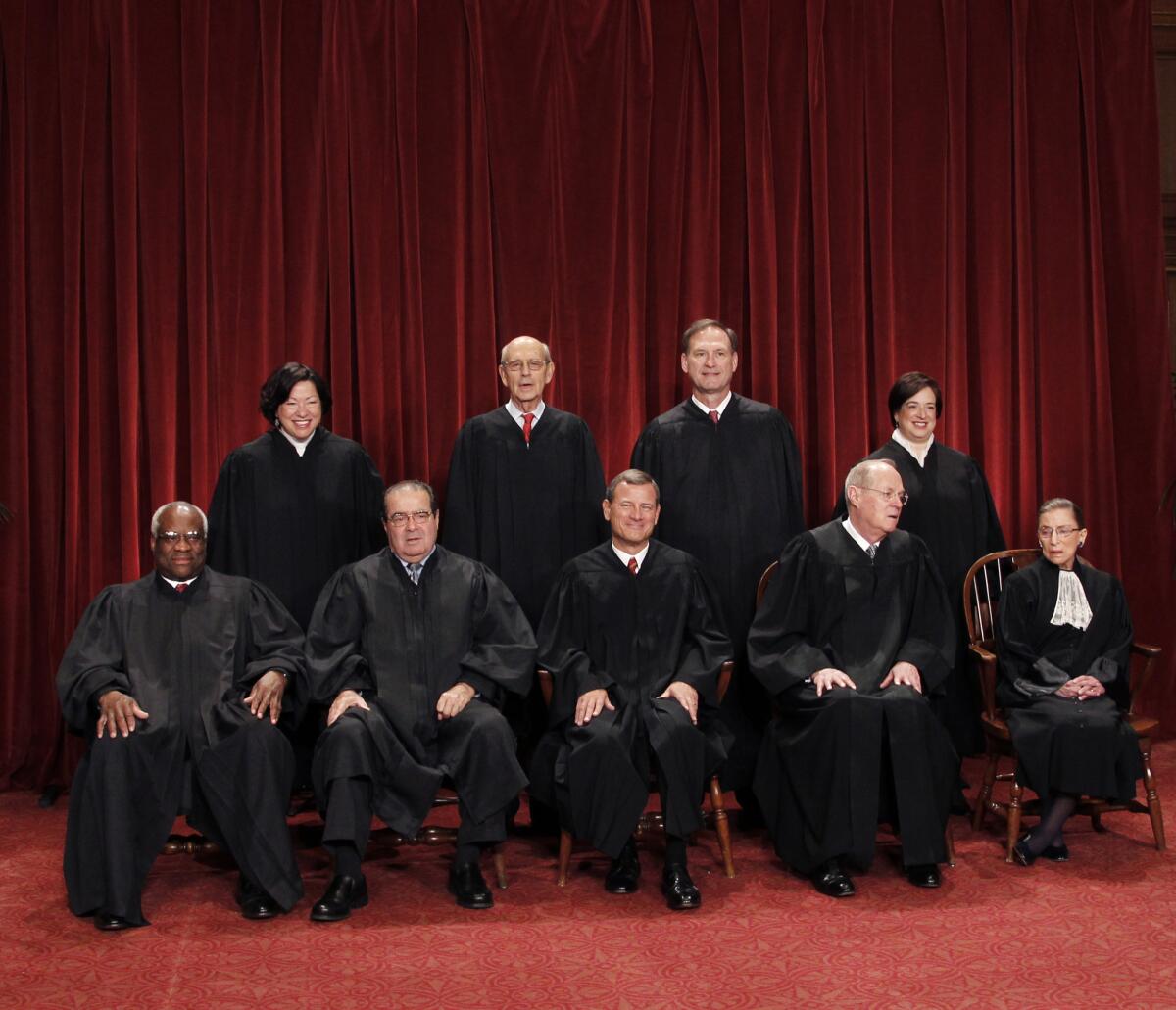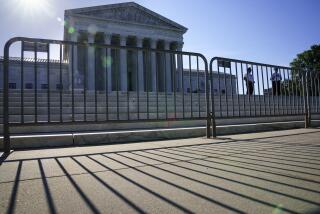Editorial: The Supreme Court could use some fixing

The justices of the U.S. Supreme Court in a group portrait at the Supreme Court Building in Washington on October 8, 2010.
- Share via
Former Arkansas Gov. Mike Huckabee says that the Supreme Court is “not the Supreme Being,” and that if elected president, he would unilaterally act to ban abortion notwithstanding the court’s decision in Roe vs. Wade. Sen. Ted Cruz of Texas, a onetime Supreme Court law clerk, has accused his former employers of acting as a “super legislature” and has proposed a constitutional amendment to require justices to face periodic retention elections.
But it isn’t just Republican presidential candidates who are criticizing the court. A group called Fix the Court has proposed that the justices be required to adhere to a code of ethics that currently applies only to lower federal court judges, and that members of the Supreme Court serve for only 18 years. Echoing long-standing complaints from the news media, the group also has faulted the court for refusing to follow Congress’ lead and televise its public proceedings.
Some of the criticisms can be dismissed as political grandstanding, but others focus on problems with the way the court functions that corrode its credibility. They can be addressed without undermining the court’s independence.
Cruz’s complaint that the court is “disregarding the views of the American people” is part of a long and bipartisan tradition of accusing “unelected judges” of usurping legislative authority. Conservatives leveled that charge when the court struck down restrictions on abortion and, more recently, same-sex marriage. It was the liberals’ turn when the court invalidated restrictions on political activity by corporations in the Citizens United decision.
Some decisions overruling the democratic process are more defensible than others. For example, the decision striking down bans on same-sex marriage was based on important constitutional principles of due process and equal protection that the court has taken the lead in defining throughout American history. By contrast, a 2013 decision gutting a key provision of the Voting Rights Act flouted the Constitution’s clear granting of authority to Congress to enforce the 15th Amendment’s ban on racial discrimination in voting. That said, “judicial activism” is often in the eye of the beholder.
Yet regardless of what one thinks of particular rulings, the court’s role as the final arbiter of the meaning of the Constitution is vital and depends on the justices’ insulation from politics. Retention elections would undermine that independence by tempting justices to curry favor with voters. And one can only imagine the special-interest money that would pour into retention campaigns for the highest court in the land.
A different question is whether justices should remain on the court well into old age, an issue that is intertwined with the temptation for justices to time their retirement in a way that makes it more likely that they will be succeeded by someone with similar views. (Justice Ruth Bader Ginsburg, at 82 the oldest member of the court, has resisted calls from liberal commentators to step down in time for President Obama to nominate a successor.)
Fix the Court urges that the next nominee to the Supreme Court pledge to serve only 18 years. That’s an idle dream, but the Constitution could be amended to replace life tenure with a fixed term. Limiting justices to 18 years would preserve their independence while reducing the likelihood that they would delay their retirement for political reasons. The idea is at least worth discussing.
Congress and the justices also need to address questions about real and apparent conflicts of interest on the court. Supreme Court justices aren’t covered by the Code of Conduct for United States Judges promulgated by the U.S. Judicial Conference. Chief Justice John G. Roberts Jr. has suggested this isn’t a problem because the code serves as “the starting point and a key source of guidance” for the justices. Still, in some respects they are less constrained than their lower court brethren.
For example, while both justices and lower court judges are mentioned in a statute setting forth the reasons for jurists to recuse themselves from a case, justices aren’t covered by an advisory opinion by the Judicial Conference dealing with recusals triggered by certain “friend of the court” briefs — specifically, cases in which a judge owns stock in a company that has filed a “friend of the court” brief in a case to which it isn’t a party but whose outcome could affect its financial position. That opinion suggests that, in some cases, a judge in that situation should withdraw from the case.
According to a report by Fix the Court, the high court heard 19 cases between Jan. 1, 2009, and Dec. 31, 2013, in which friend-of-the-court briefs were filed by companies in which one or more justices owned stock. One way for those justices to obviate the appearance problem created by such holdings would be to place their securities in blind trusts during their tenure.
Another reform that would inspire greater confidence in the court would be a requirement that justices explain why they chose to withdraw from a case — or why a request that they do so was rejected. At present, each justice is left to decide whether to provide an explanation.
Finally, although the court’s deliberations are necessarily confidential, there is no reason its public proceedings — oral arguments and the announcement of opinions — shouldn’t be televised. The court has taken some steps toward transparency by posting audio of arguments on its website shortly after they’re heard. It should go the last mile and allow the public to see the justices and the advocates as well as hear them.
The Supreme Court’s independence is essential, which is why politically motivated attacks on the court must be rejected. But the justices can and should be more open about how they do their important work.
Follow the Opinion section on Twitter @latimesopinion and Facebook
More to Read
A cure for the common opinion
Get thought-provoking perspectives with our weekly newsletter.
You may occasionally receive promotional content from the Los Angeles Times.






